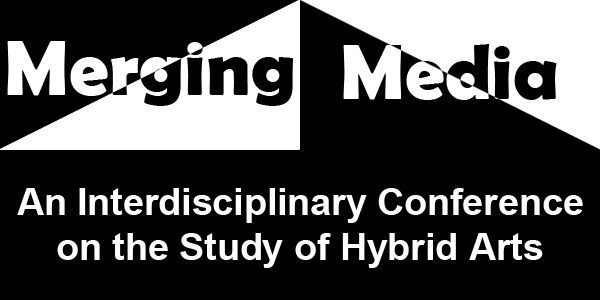Merging Media: An Interdisciplinary Conference on the Study of Hybrid Arts
Call for Papers
Saturday 1st February 2014
University of Kent, Canterbury
Although we naturally recognise different artistic media as distinct forms – music, painting, sculpture, film, dance, theatre, architecture, animation, and so on – we also understand that these mediums can nevertheless have a meaningful dialogue in the creation of new artworks. Over the course of art history there have been numerous occasions when different media forms have merged or been juxtaposed for artistic purposes. These intermedial examples have seen word and image intertwined on the page in the illuminated books of William Blake; experimentation with the partnership between painting and music in Modest Mussorgsky’s Pictures at an Exhibition; performance and music mixed in Variations by John Cage; the deconstruction of paintings through digital visual manipulation in Peter Greenaway’s lectures; and the recent National Theatre Live and Royal Opera House theatrical performances being broadcast onto cinema screens. These instances – and many more – demonstrate a long tradition of medium boundaries being crossed, media being combined to accentuate one another, or the creation of a new medium altogether.
It is particularly relevant to consider the subject of merging media at a time when discussions of media archaeologies, media convergence and the transmedia phenomena permeate contemporary academic debates. This conference seeks to engage with these topics by exploring the theories and histories of hybrid art, as well as the effect new technologies have upon our understanding of this concept. The emergence of digital technologies is an important strand in this investigation because it has both facilitated the creation of new art forms (such as 3D digital animation) and generated the remediation of older forms (for example, the digitisation of literature for consumption on computerised devices, and new forms of interaction with fine art online through virtual galleries).
This one-day conference is for postgraduate students and early career researchers whose work incorporates the interdisciplinary topic of artistic hybridity and intermediality. We invite proposals for 20-minute presentations (individual papers or pre-formed 3-paper panels) or performance pieces from candidates across arts and humanities. We welcome papers, panels and performances that investigate “merging media” through a variety of interpretations. Possible research topics for submission can include, but are not limited to:
- Hybridity of forms: case studies which explore instances where two or more established art forms are combined. What is the effect of this hybridisation?
- Hybridity and technology: the impact of new technologies upon intermedial art forms, both past and present. Does technology facilitate the “merging” of media for artistic purposes, or is this an inevitable side-effect of – and an unavoidable trajectory towards – a larger media convergence culture?
- Hybridity and history: specific case studies of merged media from the past, from Wagner’s conception of gesamtkunstwerk – where all art-forms are united as one total art – to the revolutionary intermedial ‘decadence’ of Warhol’s Exploding Plastic Inevitable, and others.
- Hybridity of performance: how performance is incorporated with various art media, from architecture in site-specific performances, to video in multi-media productions. How do we engage with performance through technology? How does the notion of “intermedial” relate to the performance of art?
- Hybridity and the audience: what effect does a “hybrid art” form have upon its audience? How does merging media provide new opportunities for engaging with artworks?
- Hybridity and remix culture: how various art forms are recycled and reused in the establishment of new works of art (e.g. the reprocessing of “found footage” for the purposes of art; fan-made hybrid products).
- Hybridity and modes of production: ways in which hybridisation impacts upon the production or creation of an artwork. What relationship does this production have with the development and influence of new technologies? What implications do intermedial modes have upon the idea of a singular artist? Which organisations or institutions inspire or enable the creation of hybrid art?
- Hybridity and sites of exhibition: what is the relationship between the intermedial art and how it is exhibited? Is there a convergence between performance and exhibition? How is the exhibition of such work impacted by technology? Or is it technological itself (such as the internet)?
- Hybridity and theory: work on the historical or future discourse of intermediality. What implication does contemporary “merging media” hold for theory? How should hybrid arts be theorised and which elements – such as production, exhibition or audience interaction – should be centralised in this scholarly debate?
Please send abstracts (300 words) for proposed papers, panels or performances and a short biographical note to mergingmedia2014@gmail.com
Deadline for submissions is 13th December 2013. Should you have any queries, please contact us at the e-mail address above.
Conference Organisation Committee
Emre Caglayan, Frances Kamm, Keeley Saunders, Pete Sillett
Web: http://blogs.kent.ac.uk/mergingmedia/
http://www.kent.ac.uk/arts/news-summary.html?view=128
Twitter: @mergingmedia14
